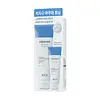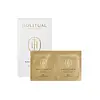What's inside
What's inside
 Key Ingredients
Key Ingredients

 Benefits
Benefits

 Concerns
Concerns

No concerns
 Ingredients Side-by-side
Ingredients Side-by-side

Water
Skin ConditioningCellulose
AbsorbentGlycerin
HumectantPropanediol
SolventButylene Glycol
Humectant1,2-Hexanediol
Skin ConditioningBetaine
HumectantSaccharide Isomerate
HumectantTromethamine
BufferingCarbomer
Emulsion StabilisingAcrylates/C10-30 Alkyl Acrylate Crosspolymer
Emulsion StabilisingPolyacrylate Crosspolymer-6
Emulsion StabilisingC12-14 Pareth-12
EmulsifyingEthylhexylglycerin
Skin ConditioningGlyceryl Acrylate/Acrylic Acid Copolymer
HumectantDisodium EDTA
Sodium Citrate
BufferingCitric Acid
BufferingCaprylic/Capric Triglyceride
MaskingCeramide NP
Skin ConditioningHydrogenated Lecithin
EmulsifyingNiacinamide
SmoothingGluconolactone
Skin ConditioningAscorbyl Glucoside
AntioxidantButene
Xylitylglucoside
HumectantAnhydroxylitol
HumectantTocopherol
AntioxidantXylitol
HumectantHydrolyzed Collagen
EmollientWater, Cellulose, Glycerin, Propanediol, Butylene Glycol, 1,2-Hexanediol, Betaine, Saccharide Isomerate, Tromethamine, Carbomer, Acrylates/C10-30 Alkyl Acrylate Crosspolymer, Polyacrylate Crosspolymer-6, C12-14 Pareth-12, Ethylhexylglycerin, Glyceryl Acrylate/Acrylic Acid Copolymer, Disodium EDTA, Sodium Citrate, Citric Acid, Caprylic/Capric Triglyceride, Ceramide NP, Hydrogenated Lecithin, Niacinamide, Gluconolactone, Ascorbyl Glucoside, Butene, Xylitylglucoside, Anhydroxylitol, Tocopherol, Xylitol, Hydrolyzed Collagen
Water
Skin ConditioningButylene Glycol
HumectantGluconolactone
Skin ConditioningDipropylene Glycol
HumectantTromethamine
Buffering1,2-Hexanediol
Skin ConditioningPolysorbate 80
EmulsifyingTocopheryl Acetate
AntioxidantEthylhexylglycerin
Skin ConditioningDisodium EDTA
Parfum
MaskingLimonene
PerfumingAnanas Sativus Fruit Extract
Skin ConditioningLinalool
PerfumingGlycerin
HumectantGeraniol
PerfumingCarica Papaya Fruit Extract
Skin ConditioningHydrogenated Lecithin
EmulsifyingPolyglyceryl-10 Stearate
Skin ConditioningPanthenol
Skin ConditioningSodium Ascorbyl Phosphate
AntioxidantNiacinamide
SmoothingBiotin
AntiseborrhoeicFolic Acid
Skin ConditioningPyridoxine
Skin ConditioningTocopherol
AntioxidantCyanocobalamin
Skin ConditioningBeta-Carotene
Skin ConditioningInositol
HumectantLinoleic Acid
CleansingRiboflavin
Cosmetic ColorantPolyglyceryl-10 Myristate
Skin ConditioningTrehalose
HumectantAdenosine
Skin ConditioningAmmonium Acryloyldimethyltaurate/Vp Copolymer
Methyl Methacrylate/Acrylonitrile Copolymer
Aureobasidium Pullulans Ferment
Skin ConditioningResveratrol
AntioxidantBifida Ferment Lysate
Skin ConditioningSodium Hyaluronate
HumectantLactococcus Ferment Lysate
Skin ConditioningLeontopodium Alpinum Callus Culture Extract
AntioxidantCopper Tripeptide-1
Skin ConditioningPalmitoyl Pentapeptide-4
Skin ConditioningTripeptide-1
Skin ConditioningDipeptide-2
Skin ConditioningOligopeptide-1
Skin ConditioningWater, Butylene Glycol, Gluconolactone, Dipropylene Glycol, Tromethamine, 1,2-Hexanediol, Polysorbate 80, Tocopheryl Acetate, Ethylhexylglycerin, Disodium EDTA, Parfum, Limonene, Ananas Sativus Fruit Extract, Linalool, Glycerin, Geraniol, Carica Papaya Fruit Extract, Hydrogenated Lecithin, Polyglyceryl-10 Stearate, Panthenol, Sodium Ascorbyl Phosphate, Niacinamide, Biotin, Folic Acid, Pyridoxine, Tocopherol, Cyanocobalamin, Beta-Carotene, Inositol, Linoleic Acid, Riboflavin, Polyglyceryl-10 Myristate, Trehalose, Adenosine, Ammonium Acryloyldimethyltaurate/Vp Copolymer, Methyl Methacrylate/Acrylonitrile Copolymer, Aureobasidium Pullulans Ferment, Resveratrol, Bifida Ferment Lysate, Sodium Hyaluronate, Lactococcus Ferment Lysate, Leontopodium Alpinum Callus Culture Extract, Copper Tripeptide-1, Palmitoyl Pentapeptide-4, Tripeptide-1, Dipeptide-2, Oligopeptide-1
 Reviews
Reviews

Ingredients Explained
These ingredients are found in both products.
Ingredients higher up in an ingredient list are typically present in a larger amount.
1,2-Hexanediol is a synthetic liquid and another multi-functional powerhouse.
It is a:
- Humectant, drawing moisture into the skin
- Emollient, helping to soften skin
- Solvent, dispersing and stabilizing formulas
- Preservative booster, enhancing the antimicrobial activity of other preservatives
Butylene Glycol (or BG) is used within cosmetic products for a few different reasons:
Overall, Butylene Glycol is a safe and well-rounded ingredient that works well with other ingredients.
Though this ingredient works well with most skin types, some people with sensitive skin may experience a reaction such as allergic rashes, closed comedones, or itchiness.
Learn more about Butylene GlycolDisodium EDTA plays a role in making products more stable by aiding other preservatives.
It is a chelating agent, meaning it neutralizes metal ions that may be found in a product.
Disodium EDTA is a salt of edetic acid and is found to be safe in cosmetic ingredients.
Learn more about Disodium EDTAEthylhexylglycerin (we can't pronounce this either) is commonly used as a preservative and skin softener. It is derived from glyceryl.
You might see Ethylhexylglycerin often paired with other preservatives such as phenoxyethanol. Ethylhexylglycerin has been found to increase the effectiveness of these other preservatives.
Gluconolactone is a PHA. PHAs are a great gentle alternative to traditional AHAs.
When applied, Gluconolactone has the same affect on skin as AHAs such as lactic acid. It helps dissolve the dead skin cells in the top layer of your skin. This improves texture and brightens the skin.
PHAs are more gentle than AHAs due to their larger structure. They do not penetrate as deeply as AHAs and take a longer time to dissolve dead cells. Studies show PHAs do not cause as much irritation.
Gluconolactone has some interesting properties:
In a 2004 study, Gluconolactone was found to prevent UV damage in mouse skin cells and has not been found to increase sun sensitivity. However, we still recommend wearing SPF daily.
This ingredient is is an created by reacting gluconic acid with an alcohol.
Learn more about GluconolactoneGlycerin is already naturally found in your skin. It helps moisturize and protect your skin.
A study from 2016 found glycerin to be more effective as a humectant than AHAs and hyaluronic acid.
As a humectant, it helps the skin stay hydrated by pulling moisture to your skin. The low molecular weight of glycerin allows it to pull moisture into the deeper layers of your skin.
Hydrated skin improves your skin barrier; Your skin barrier helps protect against irritants and bacteria.
Glycerin has also been found to have antimicrobial and antiviral properties. Due to these properties, glycerin is often used in wound and burn treatments.
In cosmetics, glycerin is usually derived from plants such as soybean or palm. However, it can also be sourced from animals, such as tallow or animal fat.
This ingredient is organic, colorless, odorless, and non-toxic.
Glycerin is the name for this ingredient in American English. British English uses Glycerol/Glycerine.
Learn more about GlycerinHydrogenated Lecithin is created from the hydrogenation of lecithin (a group of phospholipids). Hydrogenation is a chemical reaction between hydrogen and another element.
This ingredient is an emollient and emulsifier. As an emollient, it helps soften skin by trapping moisture within. As an emulsifier, it prevents oil and water ingredients from separating.
Niacinamide is a multitasking form of vitamin B3 that strengthens the skin barrier, reduces pores and dark spots, regulates oil, and improves signs of aging.
And the best part? It's gentle and well-tolerated by most skin types, including sensitive and reactive skin.
You might have heard of "niacin flush", or the reddening of skin that causes itchiness. Niacinamide has not been found to cause this.
In very rare cases, some individuals may not be able to tolerate niacinamide at all or experience an allergic reaction to it.
If you are experiencing flaking, irritation, and dryness with this ingredient, be sure to double check all your products as this ingredient can be found in all categories of skincare.
When incorporating niacinamide into your routine, look out for concentration amounts. Typically, 5% niacinamide provides benefits such as fading dark spots. However, if you have sensitive skin, it is better to begin with a smaller concentration.
When you apply niacinamide to your skin, your body converts it into nicotinamide adenine dinucleotide (NAD). NAD is an essential coenzyme that is already found in your cells as "fuel" and powers countless biological processes.
In your skin, NAD helps repair cell damage, produce new healthy cells, support collagen production, strengthen the skin barrier, and fight environmental stressors (like UV and pollution).
Our natural NAD levels start to decline with age, leading to slower skin repair, visible aging, and a weaker skin barrier. By providing your skin niacinamide, you're recharging your skin's NAD levels. This leads to stronger, healthier, and younger looking skin.
Another name for vitamin B3 is nicotinamide. This vitamin is water-soluble and our bodies don't store it. We obtain Vitamin B3 from either food or skincare. Meat, fish, wheat, yeast, and leafy greens contain vitamin B3.
The type of niacinamide used in skincare is synthetically created.
Learn more about NiacinamideTocopherol (also known as Vitamin E) is a common antioxidant used to help protect the skin from free-radicals and strengthen the skin barrier. It's also fat soluble - this means our skin is great at absorbing it.
Vitamin E also helps keep your natural skin lipids healthy. Your lipid skin barrier naturally consists of lipids, ceramides, and fatty acids. Vitamin E offers extra protection for your skin’s lipid barrier, keeping your skin healthy and nourished.
Another benefit is a bit of UV protection. Vitamin E helps reduce the damage caused by UVB rays. (It should not replace your sunscreen). Combining it with Vitamin C can decrease sunburned cells and hyperpigmentation after UV exposure.
You might have noticed Vitamin E + C often paired together. This is because it is great at stabilizing Vitamin C. Using the two together helps increase the effectiveness of both ingredients.
There are often claims that Vitamin E can reduce/prevent scarring, but these claims haven't been confirmed by scientific research.
Learn more about TocopherolTromethamine helps balance the pH and improve the texture of a product. It is synthetically created.
As an emulsifier, Tromethamine prevents oil and water ingredients from separating. This helps stabilize the product and elongate a product's shelf life. Tromethamine also makes a product thicker.
Tromethamine helps balance the pH level of a product. Normal pH level of skin is slightly acidic (~4.75-5.5). The acidity of our skin is maintained by our glands and skin biome. Being slightly acidic allows our skin to create an "acid mantle". This acid mantle is a thin barrier that protects our skin from bacteria and contaminants.
Oral Tromethanmine is an anti-inflammatory drug but plays the role of masking, adding fragrance, and/or balancing pH in skincare.
1,3-Propanediol, 2-amino-2-(hydroxymethyl)-
Learn more about TromethamineWater. It's the most common cosmetic ingredient of all. You'll usually see it at the top of ingredient lists, meaning that it makes up the largest part of the product.
So why is it so popular? Water most often acts as a solvent - this means that it helps dissolve other ingredients into the formulation.
You'll also recognize water as that liquid we all need to stay alive. If you see this, drink a glass of water. Stay hydrated!
Learn more about Water